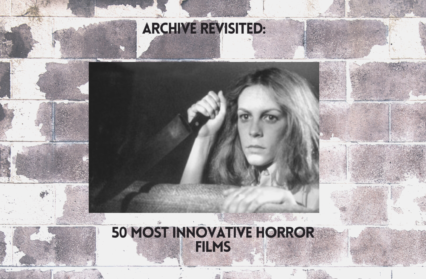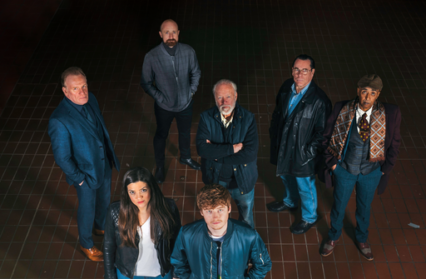Here Gary Raymond offers a defence for the 2012 Neil Jordan vampire-flick movie, Byzantium which has seen its fair share of heavy criticism.
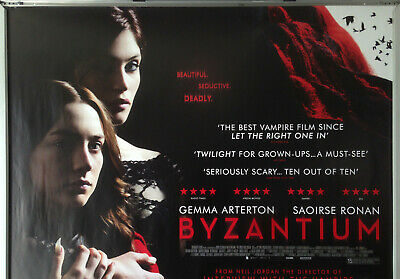
Amidst the myriad faults, not least the over-acting and claustrophobic plasticity, of Francis Ford Coppola’s 1992 Bram Stoker’s Dracula there lie an important transition in the story of the vampire myth in mainstream popular culture: Coppola went to great lengths to humanise the villain of the piece. In Stoker’s 1897 novel, the vampiric count is the epitome of the sexual predator, an ancient evil, the callousness of his spirit often associated with language akin to that of Biblical damnation by Abraham Van Helsing. By the time of Gary Oldman’s interpretation in the Coppola film he is a figure of high-tragedy – Wagnerian in fact – roaming the ages looking for the re-incarnation of the great love he lost in battle, no less damned, but now corrupted by time and longing. It is a grand and wonderful premise that only Keanu Reeves’ accent and Cary Elwes’ superior duffness can undo.
But this is not an innovation to the nature of an ancient myth, preserved in gothic amber by Stoker almost a hundred years before Coppola’s film hit the screen. The reason why the vampire myth is so powerful, so endearing, is threefold: it is about obsession, loneliness and sex. In other words: Love. This has always been the case. But the mainstream, for almost all of cinema’s history, has ignored this tract, instead of casting the vampire as inhuman, monstrous and an embodiment of demonic evil. Dracula’s most memorable early film incarnation, as F.W. Murnau’s Count Orlock in 1922’s Nosferatu, is entirely demonic. Since then the mainstream has given us Bela Lugosi’s high society camp vamp, Christopher Lee’s hissing feral aristocrat, the gangster goths of Blade and, of course, the vegetarian gap models of Twilight. Lugosi was of his time (early Universal conveyor belts), Lee of his place (Hammer’s wonderful ninety-minute penny dreadfuls), Blade of its genre (macho comic book snarling) and Twilight of its theme (sexless anaemic Sunday School lessons). But away from the gaunt podginess of the mainstream, vampire movies have been doing something far more interesting, more profound, and satisfyingly bleak for fifty-plus years.
Great horror cinema says something deep and cutting (if you’ll excuse the phrase) about us who watch and, more importantly, those around us who refuse to watch. George A. Romero turned zombies into high satire. Dawn of the Dead (1978) is the Catch-22 of horror flicks. Tobe Hooper, even, said something extremely uncomfortable in the absences of A Texas Chainsaw Massacre. But there is a reason why the vampire has taken so well to the screen where other ancient ghouls have only had their fifteen minutes of fame. They are adaptable, of course, as villains; they can come in many guises (as noted above). But they always look like us, even when at their most dangerous (unless their faces contort as they often do in post-Buffy visual parlance).
That vampires now seem so connected to teen culture is fairly new, and is certainly new to the mainstream. Stephanie Meyer did both a cynical and interesting thing to the idea of the vampire with her Twilight creation, and that was to take away their threat. In her teen Abstinence marketing strategy she made sex the great evil, rather than the original fear imposed by vampires: that of murder at one’s most vulnerable and wanton. (Consensual sex, of course, is not frightening beyond the usual earthly insecurities, whereas Abstinence poster boys, the Jonas Brothers, are absolutely terrifying). Meyer subverted the danger and made history’s most popular and unthreatening monsters; the non-bloodsuckers for the OC generation. In Meyer’s world sex is the killer, and the only time anybody does have sex, not only does it completely ruin a very plush beach hut, but it results in a baby that eats its way out of the mother. One wonders what David Cronenberg might have done with the movie rights.
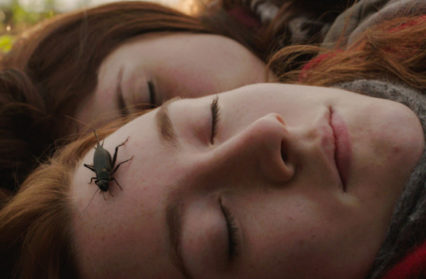
That Edward Cullen mopes around and tries to (unconvincingly) dissuade Bella Swan from falling in love with him, however, is not just teen lit shorthand for enigmatic-boy-gets-together-with-new-girl-in-town. He is aware of the perils of mortality when it comes to relationships. One of the books’ attractions is Meyer’s indulgence in the luscious backstories of her modern vampires. The films tend to leave all this out, concentrating on the lingering slo-mo shots of R-Patz moping in the woods instead. So in the films, Edward Cullen, and the characters that mill around him looking like the models for Hilfiger’s Matrix Season, are forced to hope, largely, that the audience has either come to the film as a reader of the books or has some understanding of the loneliness of being undead. The films tend not to linger on this point; they just hand over expositional moodiness and get on to the CGI will-they-won’t-they. To this effect, The Twilight Saga is largely irrelevant in the significance of the vampire myth. It is a story about two young people who fall in love even though they seem quite unsuited to each other. It is West Side Story in the shade or even Grease in the grey Cascades of Washington State. Twilight has hijacked the vampire myth, not possessed it.
So the comparison of Twilight to Neil Jordan’s latest film, a modern-day vampire fable about the wanderings of mother and daughter Clara and Eleanor, Byzantium, is as misfiring as any low-brow lazy comparison I have come across in a long time. It would be like comparing Jaws to Titanic, because of their maritime cousinship. Byzantium’s stablemates are Harry Kummel’s 1971 Belgian vampire classic Daughters of Darkness, Tony Scott’s 1983 The Hunger (with David Bowie and Catherine Deneuve), and modern masterpiece Let the Right One In, directed by Tomas Alfredson in 2004. In many ways, in fact, Byzantium is a coming together of these three films, melded with that unique Jordan panache.
The Neil Jordan film is long and narratively complex, moving back and forth through time to tell the story of Clara (Gemma Arterton), the oldest practitioner of the oldest profession in the business, and Eleanor (Saoirse Ronan), forever sixteen. Clara is pragmatic, a creature of others’ making in several ways. Eleanor is the heart of the story, crying out for an escape, or at least, just for someone to listen. She writes her story over and over again, destroying the pages once finished. That some critics have seen this as a play on woe-is-me teenagerdom (which is pretty much all that Twilight is about – nothing wrong with that, of course!) is a brutally crass reading of Ronan’s immaculate performance and Jordan’s ongoing exploration of the nebulous, primal and obsessional nature of human storytelling.
Eleanor is forever sixteen in body and in spirit, but she is all of her two centuries when it comes to weariness. When she allows peer friendship into her life it is the learning process not of an outcast, but of someone who is out of age with her group. Ronan’s balance is remarkable, her quietness is held throughout, apart from one memorable scene where she finally hits out at her mother, and another where she unveils herself to her college tutor (the most chilling scene in the film, and all done with a script, two superb actors [Maria Doyle Kennedy is the other] and their close-ups. Not a CGI werewolf in sight). If it wasn’t obvious before Byzantium (and it was very obvious), Saoirse Ronan will be a major talent in cinema for the rest of her life, and lazy patronising journalists had better soon learned to pronounce her forename correctly.
Byzantium is about many things, and not about monsters, or supernatural shenanigans. Jordan returns to two of his favourite motifs, and the ones that have brought him the most success in the area of folklore: the nature of storytelling, and the colour red (Byzantium is merciful – and mercilessly – gory where it needs to be). In 1984, Jordan collaborated with Angela Carter on the deeply unsettling dream-horror adaptation of Carter’s own adaptations of folktales, in The Company of Wolves. In many ways, Byzantium has more in common with this than one of Jordan’s biggest hits as a director, Interview with a Vampire, which treads more obviously similar narrative paths. What Jordan is really interested in is how humans relate stories to each other, how myth is born, and where the truth lies within these stories. In Byzantium, Eleanor’s redemption comes from her obsession with her own story, and the stories of her kind (‘sucrients’, a rather nice twist on the folky parochialism of the different names given to mythological bloodsuckers over the ages). When Sam Riley (who never looks better than when walking against the backdrop of a bleak English seaside town) turns up as the fabled vampire Darvell, Eleanor is forced to immediately evaluate the figure she meets with the one she has heard about in the stories of her mother. That Darvell finds his own nobility in his encounter with Eleanor is an extremely important point in the evolution of Jordan’s career motif: that for all the mud and barnacles of time, there is a kernel of truth to every story, and that truth is the redemptive ingredient, that truth is the humanity.
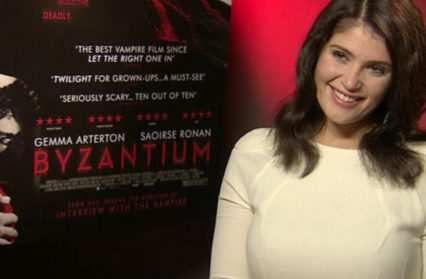
So we return to the core of the power of the vampire myth: love, in its three parts: Loneliness, obsession and sex.
Loneliness permeates the film. Everyone in Byzantium is lonely – even down to Tom Hollander’s cameo as the creative writing teacher who cannot connect with his students. Loneliness and longevity are inseparable, and companionship does very little to assuage this inevitability of the human condition. The tragedy of the vampire lies in the same place as their fearsomeness; the simultaneous humanness and the inhumanness of them. There is the suggestion that loneliness is a very modern plague, but it is more than a suggestion that it is one that infects only people, or former people.
Sex is back, also, and Jordan is not afraid to confront the incompatibility of sex and loneliness. It is integral to the feminist issues of the source text (Moira Buffini’s play). That Clara turns to prostitution to solve all of the problems she and Eleanor encounter put sex back where it needs to be: at the forefront of the vampire myth. It is where the dead and the undead meet, where metaphors of bodily fluids and penetration run wild, and we become truly terrified of the things that lurk in the shadows. That Clara, in two hundred years, has found no other way to make a living, has not learned some other skills, is a striking comment in her pre-death indoctrination into the brutal code of the whorehouse by the corruption of men. That Clara professes to always look forward whilst being unable to escape the two things that she was made – a whore and a vampire – is one of many poignant tropes in the movie.
Obsession is dealt with in a surprisingly subtle way in this Neil Jordan movie. There is the compulsion to gorge on human blood, of course, but more interestingly Eleanor cannot let go of her past, no matter how much Clara pleads and decrees her to do so. It is the subtlest and most human form of obsession. That stories make us less alone could be one nail that Jordan successfully hammers at throughout his work. Whether or not they make us less lonely is something he is yet to decide upon. But this is fertile ground for one of cinema’s most interesting voices – Jordan is a prodder, a thought-provoker, and a visualise, and his films are never perfect (and sometimes they are awful); but few directors match up to such a keen interest in the eternal psychological and anthropological questions, a populist vision and a distinct style. Byzantium is thankfully not Twilight, and it is not as beautiful as Let the Right One In, as disturbing as The Hunger, or as weird as Daughters of Darkness, but it is an excellent addition to the modern development of the vampire myth and one that was much needed.
Byzantium by Neil Jordan is available through multiple online platforms now.
Gary Raymond is an editor and regular contributor to Wales Arts Review.
For other articles included in this collection, go here.


 Enjoyed this article? Support our writers directly by buying them a coffee and clicking this link.
Enjoyed this article? Support our writers directly by buying them a coffee and clicking this link.


